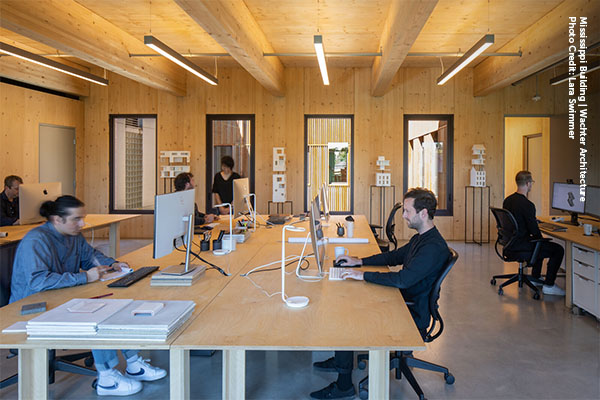HIGHLIGHTS
PROGRAM UPDATES
Wood in Architecture Awards Position SLB-Funded Program as an Industry Leader How Europe’s Performance-Based Code Approach Can Help U.S. Wood Projects International Student Design Competition to Focus on Affordable and Scalable Multi-Story Buildings Think Wood Focuses on Wood Use in Community Projects, a Sector With High Incremental Growth Potential WoodWorks Supports Design and Construction Team’s First Mass Timber ProjectProgram Updates
Wood in Architecture Awards Position SLB-Funded Program as an Industry Leader

The annual WoodWorks Wood in Architecture Awards (previously called the Wood Design Awards), which opened its 2024 competition for entries this month, play a key role in enhancing the ability of WoodWorks and the SLB to broaden the market for softwood lumber. The program is widely recognized among wood-focused design professionals, positioning WoodWorks as the go-to organization for developers and architecture, engineering, and construction firms looking for support, resources, education, and networking. The SLB’s investment in WoodWorks continues to generate value.
The program’s new name reflects enhancements this year to make the program stand out in a crowded field of design awards. Among those enhancements are increased promotion for the winners, including an award ceremony at the AIA Conference on Architecture & Design in Washington, D.C.; promotional videos; and a printed book featuring winning projects.
Promotion of the award program and winners inspires developers and design teams to consider wood for their own projects because it showcases the range of projects that can be achieved with wood solutions and demonstrates wood’s value in the context of specific design objectives. Promoting the awards also highlights WoodWorks’ knowledge and connection to the country’s most innovative wood projects and the availability of project support, education, and resources.
Beyond raising wood’s profile, the awards increase WoodWorks’ effectiveness. They keep WoodWorks up to date on innovative wood projects completed in the United States, which in turn helps WoodWorks answer project assistance inquiries. By creating a pool of example projects, the awards help WoodWorks develop resources that address emerging issues. Winners are required to have their projects on the WoodWorks Innovation Network (and nominees are encouraged to do so), helping to promote WIN and populate it with innovative projects.
Nominations for the Wood in Architecture Awards are due January 31.
How Europe’s Performance-Based Code Approach Can Help U.S. Wood Projects
The AWC has facilitated the adoption of the 2021 International Building Code (IBC) provisions for tall mass timber across the United States, with education and outreach helping to expand those provisions to 28 states/jurisdictions, thereby increasing the market for softwood lumber. But Europe had a head start on the use of mass timber; use there spread throughout the 2000s. Is there an opportunity to apply Europe’s approach in the United States? Phil Line, the AWC’s Vice President of Codes and Regulations, recently analyzed differences between U.S. codes and Eurocodes when it comes to mass timber.
In general, U.S. codes are more prescriptive, specifying the exact methods or materials to use in a building, while European codes are more performance-based, allowing for flexibility in achieving required outcomes or goals. As a result, wood systems in Europe are not categorically disallowed for certain applications. For example, the Eurocodes do not prescribe height or area allowances for mass timber buildings related to occupant safety.
Europe’s approach offers a prospective path forward in parts of the United States where mass timber is restricted. In Florida, which narrowly voted against approving mass timber provisions in its code, the AWC staff has developed The Florida Mass Timber Alternative Materials and Methods (AMM) Guide as a resource to help code officials establish requirements for approval of mass timber buildings as AMM projects—in effect, providing prescriptive guidelines for Florida projects. This approach may also be pursued in other U.S. jurisdictions that have not yet adopted mass timber code provisions to help design teams secure permits and build in accordance with the latest ICC I-Codes, boosting mass timber’s market opportunity throughout the country.
For questions or a deeper look at U.S. code trends, contact Phil Line at pline@awc.org.
International Student Design Competition to Focus on Affordable and Scalable Multi-Story Buildings
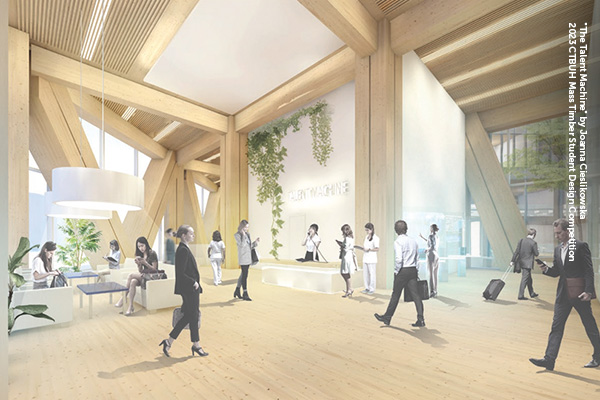
In a bold stride toward redefining the role of wood buildings in contemporary society, the SLB is sponsoring the Mass Timber Student Design Competition in collaboration with the Council on Tall Buildings and Urban Habitat (CTBUH), an international authority on urban development. By pushing the boundaries of conventional buildings and embracing mass timber, student participants are contributing to the evolution of urban spaces and using architecture to solve complex challenges facing society.
This year’s recently announced competition challenges participants to envision structures that embody a forward-looking urban response to current challenges, including population growth, urbanization, climate change, and technological advancements.
The competition’s central focus is the application of mass timber in multi-story buildings within the United States, with an emphasis on affordable housing and rapid development. Mass timber—with its lower energy footprint, carbon storage capabilities, positive impact on occupants’ well-being, and capacity for offsite production using digital fabrication—is emerging as a sustainable and innovative solution for addressing the pressing needs of our burgeoning cities. The competition urges participants to leverage the benefits of prefabricated components, especially volumetric modules, showcasing how mass timber can facilitate speed and cost savings during construction, contributing to the evolution of efficient urban spaces.
Through its sponsorship of the Mass Timber Student Design Competition and other programs like Timber in the City, the SLB is increasing investments in student education and faculty development. Investors have shown strong support for the SLB’s work in education because of its potential to have enormous long-term impact when students enter design practice with positive perceptions of wood products. The SLB’s sponsorship of these programs helps to inspire a new generation of architects to improve our urban environments with wood.
Think Wood Focuses on Wood Use in Community Projects, a Sector With High Incremental Growth Potential
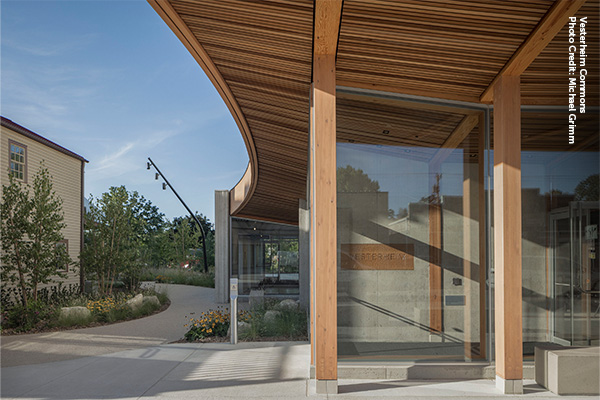
Architecture firm Snøhetta found every opportunity to use wood in its design for Vesterheim Commons, a three-story addition to the National Norwegian-American Museum and Folk Art School. Think Wood’s profile online provides an inspiring and educational illustration of this approach, in which the architect chose wood for everything from the light-frame interior partitions and exposed wood interior structure to a swooping glulam entrance and even glulam mullions instead of an aluminum curtainwall.
The profile is the latest example of Think Wood’s efforts to foster enthusiasm for wood use in community projects, a typology that covers several categories with major incremental market opportunity for wood, including education—the sector with the most incremental opportunity at 447 MM BF through 2035—as well as recreation (127 MM BF) and government (26 MM BF).
A Think Wood-sponsored continuing education webinar, “Using Wood and Mass Timber in Library and Community Projects” is another example of this approach. The December webinar attracted nearly 1,300 professionals, with speakers from the architecture firms Perkins&Will, BuildingWork, and Oudens Ello Architecture describing their approach to reshaping libraries and civic spaces through innovative wood construction.
WoodWorks Supports Design and Construction Team’s First Mass Timber Project
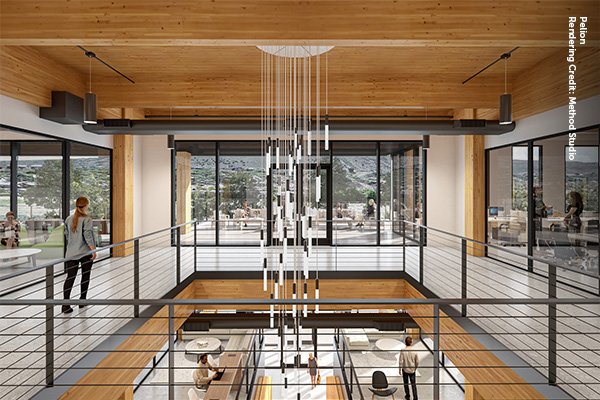
Pelion, an innovative office building in Draper, Utah, with five stories of mass timber over a concrete podium, exemplifies the value of WoodWorks support in helping firms realize successful mass timber projects when their experience lies with other materials.
Both Brian Lisonbee, an Estimator at Okland Construction, and architect Jared Wright, Vice President of Method Studio, were new to mass timber and reached out to WoodWorks after each had received assistance on other projects. A WoodWorks Regional Director discussed potential installers and procurement subs for Lisonbee and met with Wright to discuss topics such as acoustics, fire ratings, and MEP coordination.
With the project nearing construction, Lisonbee called to discuss insurance issues, and WoodWorks answered his questions and provided WoodWorks’ insurance paper along with a list of brokers with mass timber experience. Insurance was secured, and the project broke ground last June. The 125,000-square-foot project is projected to use 22.3 bf/sq. ft. and become the first mass timber project in the state.
Progress on this project could open new opportunities for wood products in Utah and the growing Salt Lake City metro area. An outlook from project management firm Cumming Group notes that the city has a strong economy and is positioning itself to capture tech companies exiting Silicon Valley, with a 2.3% increase in construction volume projected for 2024.
Spotlight
New Tests Demonstrate Mass Timber’s Fire Safety
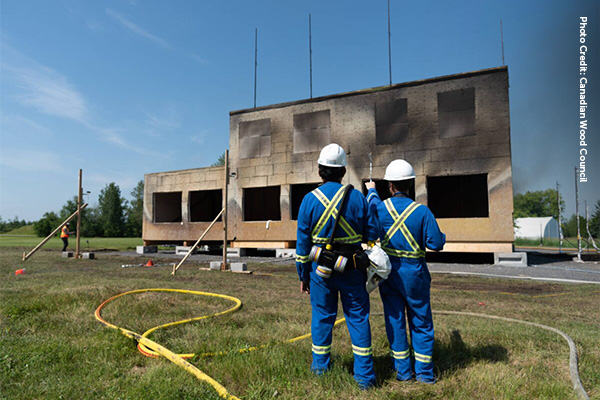
New research supported by the National Research Council of Canada and the Canadian Wood Council shows that even in worst-case fire scenarios, mass timber buildings perform similarly to noncombustible construction. The Mass Timber Demonstration Fire Test Program ran a two-story, 3,600-square-foot mass timber structure through five test scenarios, including a space similar to an open-office environment and tests that replicated a serious, unattended fire, with the structure remaining stable and solid through the cumulative effects of all five tests.
The tests in Canada add to a growing body of international research demonstrating wood’s fire-safe performance, reassuring specifiers in the design industry that wood products can achieve both design and performance goals. Research projects funded by the SLB include a glulam connection fire test conducted by Arup and the AWC’s testing of WUI-hardened structures and library of resources on designing for fire code acceptance.
Like the Natural Hazards Engineering Research Infrastructure (NHERI) TallWood Project, which was supported by the SLB, WoodWorks, Think Wood, the Binational Softwood Lumber Council, and other industry partners to demonstrate wood’s seismic resilience, the growing body of fire safety research demonstrates the power of industry collaboration, both national and international, to jointly expand the market for softwood lumber markets. The SLB will continue to find partnership opportunities, such as the Wood Innovations Grants highlighted in the first article of this newsletter, with the potential to increase new demand for the lumber industry.
Industry Resources
FEA's Housing Dashboard
This housing dashboard is provided compliments of Forest Economic Advisors (FEA)
View the December Housing Dashboard
Virginia Tech's Monthly Housing Report
This monthly housing commentary report is a free service of Virginia Tech and is intended to help one gauge future business activity in the U.S. housing market.
October 2023 Reports (released in December 2023)
Part A: October Housing Commentary
Part B: October Economic Conditions
November 2023 Reports (released in January 2024)
Part A: November Housing Commentary
Part B: November Economic Conditions


